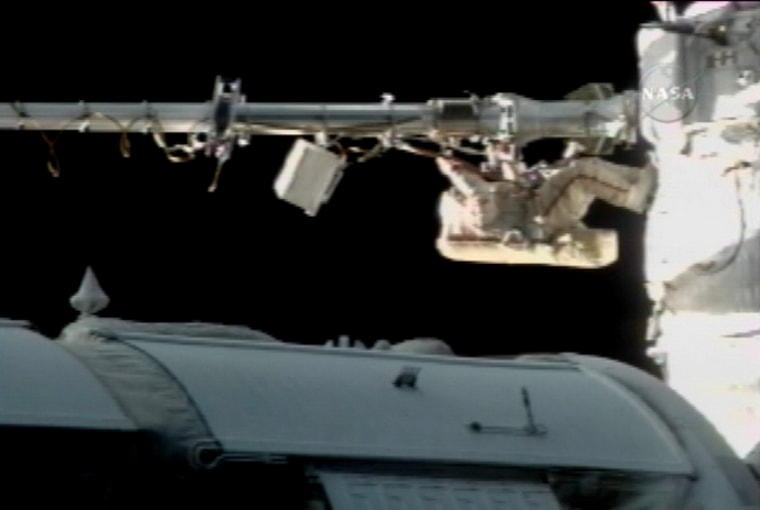Two Russian cosmonauts climbed out of the international space station Wednesday to install protective panels designed to shield the orbiting outpost from dangerous space debris.
Commander Fyodor Yurchikhin and flight engineer Oleg Kotov opened a hatch on the Russian side of the space station at 3:05 p.m. EDT. The spacewalk ended about five and a half hours later.
“Hooray! We’re back home!” one of the cosmonauts said after climbing back into the space station air lock. The only lament from the first-time spacewalkers came at the end, from a cosmonaut who complained about an ill-fitted glove on his spacesuit.
Both men were tethered during the spacewalk to keep them from floating away. The station’s third occupant, U.S. astronaut Sunita Williams, remained inside.
Addressing the greatest threat
Space debris includes objects such as discarded rocket parts, planetary dust and rocks. Scientists consider it the greatest threat to the space station, orbiting about 220 miles (350 kilometers) above Earth.
Kotov rode at the end of a crane operated by Yurchikhin to reach the stack of aluminum panels about 60 feet (18 meters) from the hatch.
The 17 protective panels, each about 2 feet by 3 feet (60 by 90 centimeters) and weighing about 20 pounds (9 kilograms), were delivered to the station last December and left outside in a formation dubbed “the Christmas tree.”
The cosmonauts installed five of the panels on a Russian section of the space station, and the others were to be put in place during a spacewalk next week.
Engineers on the ground are able to monitor by radar the largest pieces of space debris — objects larger than a softball — and adjust the station’s position accordingly, so the shielding will protect against smaller objects.
Slideshow 12 photos
Month in Space: January 2014
“The consequence of small particles is not so great,” said Kirk Shireman, NASA’s deputy program manager for the space station. “Then there are the midrange particles. Those are the ones we worry about.”
An independent safety task force in February said that there was a 9 percent risk that the space station, once completed in 2010, could be hit with space debris severe enough to cause the loss of the outpost or crew members. That risk estimate was reduced to 5 percent if protective panels were installed on Russian portions of the space station.
Sections of the space station built by NASA and the Japanese and European space agencies were protected sufficiently against space debris, the task force said.
A moonlit, ‘cloudy’ night
The spacewalk started about 45 minutes late, but a bright moon allowed the cosmonauts to catch up by working through what normally would have been darkness after orbital sunsets. The space station circles Earth every 90 minutes.
Asked by Mission Control in Moscow how it felt in their spacesuits once they were outside, one of the cosmonauts joked: “Kind of cloudy, a bit rainy. We didn’t take an umbrella with us.”
The cosmonauts also successfully rerouted a cable for a navigation antenna that will be used later in the year for the first flight of a new European cargo vehicle.
Wednesday’s spacewalk was the first of two scheduled a week apart. Yurchikhin and Kotov will perform another one next Wednesday with similar tasks, including depositing canisters containing biological experiments outside the station.
The space shuttle Atlantis and its seven astronauts are scheduled to fly to the station early next month. NASA managers on Wednesday began a two-day meeting at the Kennedy Space Center to decide whether to go ahead with the planned June 8 launch.
A final decision was expected Thursday for the launch, which previously was postponed from mid-March because of a hailstorm that damaged the insulating foam on the shuttle’s external tank.

